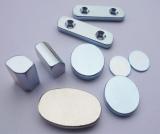Send inquiry
Neodymium Magnet(also know as NdFeB, NIB or Neo Magnet), the most widely used type of rare-earth magnet, is a permanent magnet made from an alloy of neodymium, iron and boron to form the ND2Fe14B tetragonal crytaline structure.
Neodymium magnets are the strongest type of permanent magnet made. They have replaced other types of magnet in the many applications in modern produces that require strong permanent magnets, such as motors in cordless tools, hard disk drives and magnetic fasteners.
Magnetic property of Neodymium Magnet
Grade Remanence
Br Coercive Force
Hcb Intrinsic Coercive force
Hci Max Energy Product
(BH) max Max Working Temp.
KG T KOe KA/m KOe KA/m MGOe KJ/m ºC °F
N35 11.4-11.8 1.18-1.28 ≥ 10.8 ≥ 836 ≥ 12 ≥ 955 33-36 263-287 80 176
N38 11.8-12.3 1.18-1.28 ≥ 10.8 ≥ 860 ≥ 12 ≥ 955 36-39 287-310 80 176
N40 12.7-12.9 1.27-1.29 ≥ 11.0 ≥ 876 ≥ 12 ≥ 955 38-41 303-326 80 176
N42 12.9-13.3 1.29-1.33 ≥ 10.5 ≥ 836 ≥ 12 ≥ 955 40-43 318-342 80 176
N45 13.3-13.8 1.33-1.38 ≥ 9.5 ≥ 756 ≥ 12 ≥ 955 43-46 342-366 80 176
N48 13.8-14.2 1.38-1.42 ≥ 10.5 ≥ 835 ≥ 12 ≥ 955 46-49 366-390 80 176
N50 13.8-14.5 1.38-1.45 ≥ 10.5 ≥ 835 ≥ 11 ≥ 955 47-51 374-406 80 176
N52 14.3-14.8 1.43-1.48 ≥ 10.8 ≥ 860 ≥ 11 ≥ 876 50-53 398-422 80 176
33M 11.4-11.8 1.14-1.18 ≥ 10.3 ≥ 820 ≥ 14 ≥ 1114 31-33 247-263 100 212
35M 11.8-12.3 1.18-1.23 ≥ 10.8 ≥ 860 ≥ 14 ≥ 1114 33-36 263-287 100 212
38M 12.3-12.7 1.23-1.27 ≥ 11.0 ≥ 876 ≥ 14 ≥ 1114 38-41 303-326 100 212
40M 12.7-12.9 1.27-1.29 ≥ 11.4 ≥ 907 ≥ 14 ≥ 1114 38-41 303-326 100 212
42M 12.8-13.2 1.28-1.32 ≥ 11.6 ≥ 923 ≥ 14 ≥1114 40-43 318-342 100 212
45M 13.2-13.8 1.32-1.38 ≥ 11.8 ≥ 939 ≥ 14 ≥ 1114 43-46 342-366 100 212
48M 13.6-14.0 1.36-1.40 ≥ 11.8 ≥ 939 ≥ 14 ≥ 1114 46-49 366-390 100 212
50M 14.0-14.5 1.40-1.45 ≥ 13.0 ≥ 1033 ≥ 14 ≥ 1114 48-51 382-406 100 212
30H 10.8-11.4 1.08-1.14 ≥ 10.2 ≥ 812 ≥ 17 ≥ 1353 28-31 223-247 120 248
33H 11.4-11.8 1.14-1.18 ≥ 10.6 ≥ 844 ≥ 17 ≥ 1353 31-33 247-263 120 248
35H 11.8-12.3 1.18-1.28 ≥ 11.0 ≥ 876 ≥ 17 ≥ 1353 33-36 263-287 120 248
38H 12.3-12.7 1.23-1.27 ≥ 11.2 ≥ 890 ≥ 17 ≥ 1353 36-39 287-310 120 248
40H 12.7-12.9 1.27-1.29 ≥ 11.5 ≥ 915 ≥ 17 ≥ 1353 38-41 303-326 120 248
42H 12.8-13.2 1.28-1.32 ≥ 12.0 ≥ 955 ≥ 17 ≥ 1353 40-43 318-342 120 248
45H 13.2-13.5 1.32-1.38 ≥ 12.0 ≥ 955 ≥ 17 ≥ 1353 42-46 335-366 120 248
46H 13.3-13.8 1.33-1.38 ≥ 12.2 ≥ 972 ≥ 16 ≥ 1274 44-47 350-374 120 248
48H 13.6-14.3 1.36-1.43 ≥ 12.5 ≥ 995 ≥ 16 ≥ 1274 46-49 366-390 120 248
30SH 10.8-11.4 1.081.14 ≥ 10.0 ≥ 796 ≥ 20 ≥ 1672 28-31 223-247 150 302
33SH 11.4-11.8 1.14-1.18 ≥ 10.5 ≥ 836 ≥ 20 ≥ 1672 31-34 247-276 150 302
35SH 11.8-12.3 1.18-1.23 ≥ 11.0 ≥ 876 ≥ 20 ≥ 1672 33-36 263-287 150 302
38SH 12.3-12.7 1.23-1.27 ≥ 11.4 ≥ 907 ≥ 20 ≥ 1972 36-39 287-310 150 302
40SH 12.5-12.8 1.25-1.28 ≥ 11.8 ≥ 939 ≥ 20 ≥ 1972 38-41 302-326 150 302
42SH 12.8-13.2 1.28-1.32 ≥ 11.8 ≥ 939 ≥ 20 ≥ 1672 40-43 320-343 150 302
45SH 13.2-13.8 1.32-1.38 ≥ 12.6 ≥ 1003 ≥ 20 ≥ 1592 43-46 342-366 150 302
30UH 10.8-11.4 1.08-1.14 ≥ 10.2 ≥ 812 ≥ 25 ≥ 1990 28-31 223-247 180 356
33UH 11.3-11.7 1.13-1.17 ≥ 10.7 ≥ 852 ≥ 25 ≥ 1990 31-33 247-263 180 356
35UH 11.7-12.1 1.17-1.21 ≥ 10.7 ≥ 852 ≥ 25 ≥ 1990 33-36 263-287 180 356
38UH 12.1-12.5 1.21-1.25 ≥ 11.4 ≥ 907 ≥ 25 ≥ 1990 36-39 287-310 180 356
40UH 12.5-12.8 1.25-1.28 ≥ 11.4 ≥ 907 ≥ 25 ≥ 1990 38-41 302-326 180 356
28EH 10.5-10.8 1.05-1.08 ≥ 9.5 ≥ 756 ≥ 30 ≥ 2388 26-29 207-231 200 392
30EH 10.8-11.4 1.08-1.14 ≥ 9.5 ≥ 756 ≥ 30 ≥ 2388 28-31 223-241 200 292
33EH 11.3-11.7 1.13-1.17 ≥ 10.2 ≥ 812 ≥ 30 ≥ 2388 31-33 247-263 200 392
35EH 11.7-12.1 1.17-1.21 ≥ 10.2 ≥ 812 ≥ 30 ≥ 2388 33-36 263-287 200 392
38EH 12.1-12.5 1.21-1.25 ≥ 11.4 ≥ 907 ≥ 30 ≥ 2388 36-39 287-310 200 392
30AH 10.8-11.3 1.08-1.13 ≥ 10.2 ≥ 812 ≥ 35 ≥ 2785 28-32 223-255 220 428
33AH 11.2-11.7 1.12-1.17 ≥ 10.2 ≥ 812 ≥ 35 ≥ 2785 31-34 247-271 220 428
Some important properties used to compare permanent magnets are: Remanence(Br). Which measures the strength of the magnetic field; Coercivity
(Hci), the material's resistance to becoming demagnetized; Energy product(BHmax), the density of magnetic energy; And Curie temperature(TC), the temperature at which the material loses its magnetism. Neodymium magnets have higher remanence, much higher coercivity and energy product, but often lower Curie temperature than other types. Neodvmium is alloved with terbium and dysprosium in order to preserve its magnetic properties at high temperatures. The table below compaes the magnetic performance of neodymium magnets with other types of permanent magnets.
Neodymium magnet Application of neodymium magnet:
Magnets are found in almost all modern objects. The computer hard drive Most modern mobile phones now include a small neodymium magnet or two. Like computer compenents magnets have gradually become small and smaller making them easy to integrate into most industrial manufacturing processes. We also find that a lot of model and jewelley makers like our magnets as they fit easily into their models and allow parts to be easily removed and re-attached. For lifting. Holding, separating, and retrieving, we have the right magnetic assemblies and permanent magnetic materials for all types of industrial, OEM and commercial applications. Our expertise and ability to develop customized solutions will match the correct magnet for your application.
